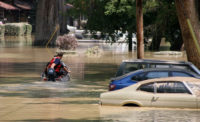Coordinating enterprise leadership response to mass casualty events

The number of mass casualty events (MCEs) has been increasing steadily over the years. MCEs range from active shooter incidents to acts of terrorism or natural disasters. While every MCE has unique issues, there is a predictability to the aftermath that can inform planning and response for future events.
Enterprise response following a mass casualty event sets the stage for further healing by survivors of MCEs. Jim Hall, former Director of the National Transportation Safety Board, often pointed out that while an organization can get a lot of things right in the aftermath of disaster, it can be very hard to regain the trust of victims if lost or not established from the beginning.
Executive response to mass casualty events
Surviving victims and families will turn to someone in charge to assure them they will be cared for and will receive help to navigate the aftermath of tragedy. It may be the most important thing a senior executive does and something for which the executive and the organization are long remembered.
Following the 1997 murders of three young employees in the Georgetown Starbucks store in Washington, D.C., CEO Howard Schultz cancelled a vacation and quickly traveled to the area where he met with employees and families of the victims. He attended a crisis counseling session with employees and took steps to increase security procedures at Starbucks stores in response to their concerns. The CEO ensured that funeral and burial costs for victims were covered. He also established a permanent memorial in the Georgetown store from which the profits go to local charities chosen by store employees. The company’s regional director was quoted at the time as saying the response "was Howard the human, not Howard the CEO." The corporate response of Starbucks and its CEO continued to be recognized in social media postings two decades later.
MCE response strategies
The best way to establish and maintain trust early on with victims and families is through transparent, frequent and empathetic communication. If a misstep occurs, it is critical to own it and quickly communicate the issue and remedies to victims and families before addressing it with the larger group of employees and people outside the organization. Video or audio conference calls can be particularly useful in disseminating information quickly when there are many victims.
Surviving victims and families may be understandably angry about what happened. They may direct their anger to someone they can see and with whom they can speak. It is best to let them express their grief and anger and listen with compassion. "I'm very sorry for your injury or your loss" is a simple but meaningful way to acknowledge their suffering. It needs to be human and very personal.
It will help to maintain a focus on victims and consider how executive decisions and actions will affect them. Be flexible whenever possible. Even the most carefully developed plan will not cover every situation. Be consistent in setting expectations and messaging with multiple victims and family groups, taking care to treat them fairly and equally. They will talk among themselves. Survivors and families are often consulted on the establishment of any memorial event or physical memorial. Acknowledge anniversaries, especially the first one.
Resilience is the ability to bounce back after a devastating experience. Most affected individuals will cope and adjust over time with consistent information, support, and understanding. Some people may experience more acute reactions and need time and treatment to recover. Providing effective and timely support to victims of MCEs will go a long way to fostering resilience in employees, their families, and the organization. How victims and survivors are treated in the aftermath has the power to help them heal.
This article originally ran in Security, a twice-monthly security-focused eNewsletter for security end users, brought to you by Security Magazine. Subscribe here.
Looking for a reprint of this article?
From high-res PDFs to custom plaques, order your copy today!






